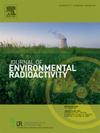Radiocesium dynamics from canopy to forest floor by main depositional processes in Fukushima forests at quasi-equilibrium state
IF 1.9
3区 环境科学与生态学
Q3 ENVIRONMENTAL SCIENCES
引用次数: 0
Abstract
Accurate measurement of the amounts of radiocesium (137Cs) that transfer from the canopy to the forest floor at the recent quasi-equilibrium state is crucial for improving the accuracy of long-term predictions of 137Cs distribution in forests. This study is the first to detail the 137Cs flux via throughfall, stemflow, and litterfall processes in two Japanese cedar forests (KU1-S and KU2-S) and one deciduous broad-leaved forest (KU1-Q) in the Fukushima Prefecture during the quasi-equilibrium state. From 2020 to 2023, the annual transfer of 137Cs from the canopy to the forest floor, relative to the initial deposition, varied among the study plots but never exceeded 2% (0.433–0.564% in KU1-S, 1.06–1.62% in KU2-S, and 0.421–0.461% in KU1-Q). Since the transfer of 137Cs from trees to soil is balanced with the transfer from soil to trees at the quasi-equilibrium state, these percentages can be interpreted as the root uptake of 137Cs from the soil, which is difficult to observe directly. Analysis of the contributions of litterfall, throughfall, and stemflow to the total transfer of 137Cs revealed that litterfall accounted for more than 50% in both Japanese cedar and deciduous broad-leaved forests. We also found that the proportion of 137Cs flux via litterfall was higher in Japanese cedar forests compared to the deciduous broad-leaved forest (KU1-S:91–92%; KU2-S:74–77%; KU1-Q:57–60%). These findings regarding the 137Cs fluxes at the quasi-equilibrium state will enhance our understanding of the future dynamics of 137Cs within forest ecosystems and improve the accuracy of long-term predictions of 137Cs activity concentration in forests.
准平衡状态下福岛森林主要沉积过程对林冠到林底放射性元素的动态影响
精确测量在最近的准平衡状态下从树冠转移到森林地面的放射性铯(137Cs)的数量对于提高对森林中137Cs分布的长期预测的准确性至关重要。本研究首次详细分析了福岛县2个杉木林(KU1-S和KU2-S)和1个落叶阔叶林(KU1-Q)在准平衡状态下的通流、茎流和凋落物过程中的137Cs通量。2020 ~ 2023年,各研究样地137Cs从林冠向地表的年迁移量相对于初始沉降量有所差异,但未超过2% (KU1-S为0.433 ~ 0.564%,KU2-S为1.06 ~ 1.62%,KU1-Q为0.421 ~ 0.461%)。由于137Cs从树木到土壤的转移与从土壤到树木的转移在准平衡状态下是平衡的,所以这些百分比可以解释为根系从土壤中吸收的137Cs,这很难直接观察到。分析凋落物、穿透物和茎流对137Cs总迁移量的贡献表明,杉木和落叶阔叶林的凋落物对137Cs总迁移量的贡献均在50%以上。研究还发现,日本杉林凋落物中137Cs通量的比例高于落叶阔叶林(KU1-S: 91-92%;KU2-S: 74 - 77%;KU1-Q: 57 - 60%)。这些关于准平衡状态下137Cs通量的发现将有助于我们对森林生态系统中137Cs未来动态的认识,并提高森林137Cs活性浓度长期预测的准确性。
本文章由计算机程序翻译,如有差异,请以英文原文为准。
求助全文
约1分钟内获得全文
求助全文
来源期刊

Journal of environmental radioactivity
环境科学-环境科学
CiteScore
4.70
自引率
13.00%
发文量
209
审稿时长
73 days
期刊介绍:
The Journal of Environmental Radioactivity provides a coherent international forum for publication of original research or review papers on any aspect of the occurrence of radioactivity in natural systems.
Relevant subject areas range from applications of environmental radionuclides as mechanistic or timescale tracers of natural processes to assessments of the radioecological or radiological effects of ambient radioactivity. Papers deal with naturally occurring nuclides or with those created and released by man through nuclear weapons manufacture and testing, energy production, fuel-cycle technology, etc. Reports on radioactivity in the oceans, sediments, rivers, lakes, groundwaters, soils, atmosphere and all divisions of the biosphere are welcomed, but these should not simply be of a monitoring nature unless the data are particularly innovative.
 求助内容:
求助内容: 应助结果提醒方式:
应助结果提醒方式:


